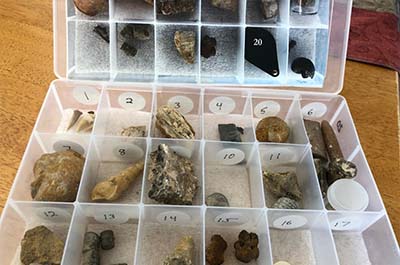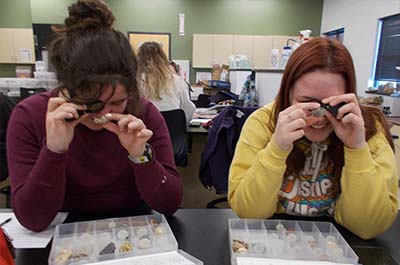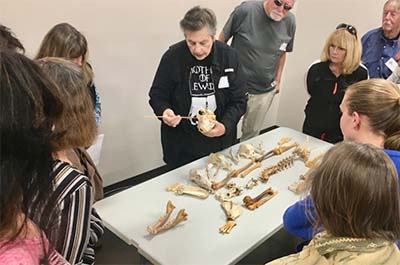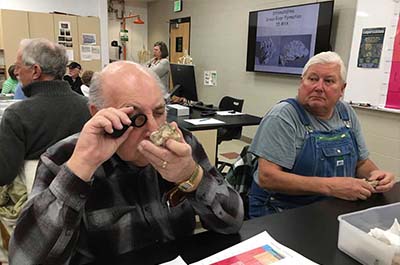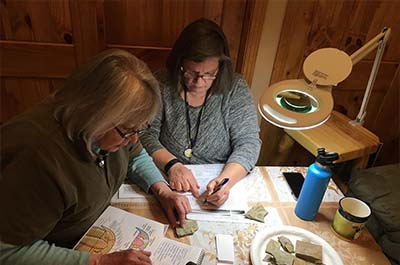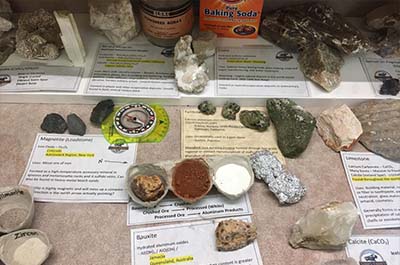Insects Trapped in Amber
Many of us are familiar with the high preservation of insects and leaves in the Green River Formation, a Colorado lagerstätte well known for field trips yielding magnificent fossils. But imagine fossils of that high quality that aren’t squashed into two dimensions but instead are preserved ‘suspended in space’ as if they are still alive.
Harold Taylor presented our November Stones ‘n Bones program on Insects Trapped in Amber. It was a magical insight into exquisite preservation.
We were able to readily identify ants, flies, spiders, wasps, crickets, and mites. And with the aid of loupes with magnification, we could easily see the hair on a fly’s back, the spikes on a cricket’s legs, details in eyes and veins in wings. One bug had beautiful stripes on its back. Many insects were translucent. Color can be preserved. Sometimes even the spider’s web is visible.
Amber is a fossilized tree resin, mostly carbon and hydrogen. The hardened resin is much like a plastic. Amber is prepared by being cut to size and then polished. Cutting amber into smaller pieces eliminates many of the gas bubbles which obscure the insects.
The oldest amber on our planet dates to 320 million years ago, but amber didn’t become abundant until about 150 million years ago, when we find many insects and arthropods suspended in the golden resin. The oldest amber containing arthropods comes from Lebanon and Jordan, and provides science with some of the oldest sampled ecosystems.
Today most of our amber comes from the Baltic area of Europe (without many fossils), the Dominican Republic, Colombia (very fossiliferous), and Madagascar.
Scientists study amber inclusions for their contribution to understanding taxonomy and evolution, and in reconstructing ecosystems as well as organisms. Trees exude resin to seal wounds from insect predation or damaging cuts. Small creatures can quickly become trapped in the resin before it hardens into amber. Today’s science is unable to match the amber with a specific tree. Frankincense is an aromatic resin.
Young amber is often called copal, though some scientists believe there is no difference between amber and copal.
Advice: Don’t expose your amber to sunlight. It is biodegradable, an unstable organic polymer, though this inevitable destruction takes place over millions of years.
One excellent reference: “What Bugged the Dinosaurs?” by George and Roberta Poinar.
More Articles from “Stones ‘n’ Bones Activities”
Fossil Boot Camp – Covid Style
Stones ‘n Bones of Fremont County traditionally presents two or three Fossil Boot Camp classes each year for school age students and adults. With COVID, that has proven a little difficult
Fossil Boot Camp for PCC Historical Geology Students
Fremont Stones ‘n Bones introduced 16 Pueblo Community College students to fossils in Steve Wolfe’s Historical Geology class.
Stones ‘n’ Bones With Villa Bella School’s 2nd Graders
“What do paleontologists do?” is the question we were asked to help answer for 50 second graders at Pueblo, Colorado’s newest elementary school on January 16, 2020.
The Close Relationship Between Man & Dog
Dr. Sue Ware returned to the Royal Gorge Dinosaur Experience for the second time, to the delight of 27 community members. She presented a program entitled “From your Campfire to your Bed: The Evolution, Importance & Relationship between Dogs and Humans”.
Fossil Boot Camp at PCC Mini-College
For the 5th straight year, Stones ‘n Bones presented Fossil Boot Camp to 31 senior citizens in the Fremont County community.
Stones ‘n’ Bones & the Enormous Egg
What happens when an entire elementary school reads the same book, The Enormous Egg, and asks Fremont County Stones and Bones to come in to help with the family night to celebrate the reading? A two-hour evening full of paleontology learning!
Introducing Geology Students to Fossils
How does Steve Wolfe, Historical Geology instructor at PCC-Fremont Campus, prepare his students for field season observations? One way is by introducing them to fossils
Identifying Trilobites
The Pioche Formation of eastern Nevada is world famous for its amazing preservation of trilobites. Very old trilobites, from the Lower Cambrian (542 – 521 million years old), almost the oldest on record.
Everything Begins With Mining
There are many ways to appreciate rocks. Many of us notice them simply for their color, texture and shape, irresistible and raw in nature.
Insects Trapped in Amber
Many of us are familiar with the high preservation of insects and leaves in the Green River Formation, a Colorado lagerstätte well known for field trips yielding magnificent fossils.

